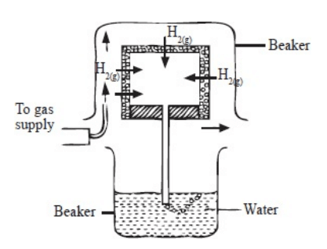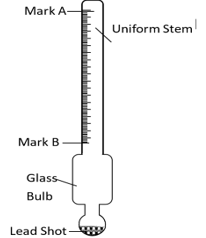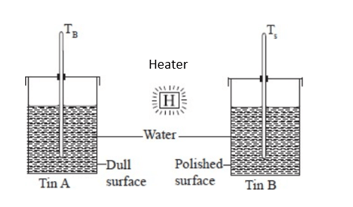INSRTRUCTIONS
- This paper consists of two sections A and B.
- Answer ALL the questions in section A and B in the spaces provided below each question.
- All working must be clearly shown.
- Non – programmable and silent calculators may be used.

QUESTIONS
SECTION A (25 MARKS)
- A spherical ball bearing is held between the anvil and spindle of a micrometer screw gauge. The reading on the gauge when the jaws are closed without anything in between is 0.11 mm.

What is the diameter of the ball bearing? (2 marks) -
- Boiling water is not used for sterilization of clinical thermometer. State the reason for this. (1 mark)
- State how the clinical thermometer is sterilized. (1 mark)
- Between mercury and alcohol, state with a reason, which of the two liquids is used in a thermometer to measure temperature in areas where temperatures are below - 40°c. (2 marks)
- State what happens to the position of C.O.G of a body in the following states of equilibrium if the body is slightly pushed.
- Stable equilibrium. (1mark)
- Unstable equilibrium. (1mark)
- Neutral equilibrium. ( 1mark)
- Using kinetic theory of matter, distinguish between solids and liquids states of matter in terms of intermolecular forces and spaces between particles. (2 marks)
- In a vacuum flask, the walls enclosing the vacuum are silvered on the inside. State the reason for this. (1 mark)
- The following data was obtained from an experiment to determine the size of palm oil molecule.
- Volume of 50 drops of palm oil = 1.5 X 10 – 9 m3
- Area of a patch from one drop of the oil. = 8.0 cm2
Determine the size of a palm oil molecule. (3 marks)
- Explain why it is dangerous for a bus to carry standing passengers. (2 marks)
- State two factors that affects the spring constant of a spring. (2 marks)
- Two liquids were sucked up in two identical tubes as shown in the figure below
Given that the liquid in beaker 2 is water of density 1 g/cm3 determine the density of liquid in beaker 1. (3 marks)
- The figure below shows an arrangement to demonstrate diffusion through a porous pot.

The hydrogen gas is supplied for sometimes then stopped and the beaker removed. State and explain what is likely to be observed when the hydrogen gas supply is stopped. (3 marks)
SECTION B (55 MARKS)
-
- State the law of conservation of linear momentum. ( 1 mark)
- A high jumper usually lands on thick mattress. Explain how the mattress helps in reducing the force of impact. (1 mark)
- A bus of mass 2500 kg travelling at a constant velocity of 15 m/s collides with a stationary car of car of mass 800 kg. The impact takes 0.5 seconds before the two move together at a constant velocity for 20 seconds.
Calculate;- The common velocity after the impact. (3 marks)
- The distance moved after the impact. (2 marks)
- The impulsive force. (3 marks)
-
- A body moving at a constant speed in a circular path is said to be accelerating. Explain. (1 mark)
- Define angular displacement. (1 mark)
- A body of mass 450g tied to s a string of length 60 cm, is moved in a horizontal circle at a constant speed of 240 revolutions per minute.
Determine;- Angular velocity of the body. (2 marks)
- Tension in the string. (2 marks)
- The above body in b) is released and falls to the ground 2.6 m below it.
Calculate;- The time it takes to reach the ground. (2 marks)
- Maximum horizontal distance it travels from the point of release. (3 marks)
-
- State Archimedes principle. (1 mark)
- An object weighs 5.2 N in air, 3.2 N when completely immersed in water and 1.8 N when completely immersed in an acid.
Calculate;- Density of the object. (3 marks)
- Density of the acid. (3 marks)
- The figure below shows a simple hydrometer which is suitable for measuring density of liquids varying between 0.8 g/cm3 and 1.2g/cm3

.State the purpose of the lead shots in the glass bulb. ( 1 mark)- State how the hydrometer would be made more sensitive. (1 mark)
- Indicate on the diagram the mark corresponding to 0.8 g/cm3 and 1.2 g/ cm3. (1 mark)
-
- Define the term specific latent heat of fusion. (1 mark)
- In an experiment to determine the specific latent heat of vaporization of water, steam at 100 oc was passed into water contained in a well lagged aluminium calorimeter. The following data measurements were made;
- mass of calorimeter = 100 g
- initial mass of water = 150 g
- initial temperature of water = 18°c
- final mass of calorimeter + water + condensed steam = 264 g
- final temperature of the mixture = 68°c
(Specific heat capacity of water = 4200J/kgK and specific heat capacity of aluminium = 400J/kgK)- Determine;
- Mass of the condensed steam. (1 mark)
- Heat gained by the calorimeter and water. (3 marks)
- Given that LV is the specific latent heat of vaporization of steam, determine the value of LV. (3 marks)
- two similar cans are partly filled with equal quantities of paraffin. Each holds a thermometer, is covered with a lid and stands on a wooden bench at the same distance from a source of radiant heat as shown below.

- Explain why heat from the heater could not have reached the cans by;
- Conduction. (1 mark)
- Convection. ( 1 mark)
- Explain why there is a difference in the thermometer readings after some time. (1 mark)
- How can the set up in the figure above be adjusted in order to produce the same results? (1 mark)
- Explain why heat from the heater could not have reached the cans by;
-
- Define velocity ratio of a machine. (1 mark)
- The effort piston of a hydraulic machine is of radius 2.8 cm, while that of the load piston is of radius 14 cm. the machine raises a load of 120 kg at a constant velocity. If the machine has an efficiency of 80%.
Calculate;- The velocity ratio of the hydraulic machine. (2 marks)
- The effort needed to raise the load. (3 marks)
- The figure below shows a hydraulic press that is worked by applying a force of 80 N ta the end of a lever 28 cm long pivoted at the other end. The smaller piston is 4 cm from the pivot. The area of the piston A is 2 cm2 and that of B is 10 cm2.

Determine;- The force applied to piston A. (2 marks)
- The force exerted on the piston B by the liquid. (2 marks)
- The mechanical advantage of the hydraulic press. (2 marks)

MARKING SCHEME
- Sleeve scale = 4.50 mm
Thimble scale = 21 X 0.01 = 0.21 mm
Total 4.71 mm (1 mark)
4.71 – 0.11 = 4.60 mm (1 mark) -
- The boiling point of water is far above the temperature range of the clinical thermometer.(1 mark)
- Using methylated spirit. (1 mark)
- Alcohol. (1 mark)
Because it has a lower freezing point than mercury. (1 mark)
OR
alcohol has a low freezing point of – 115°c compared to mercury which has -39°c. -
- C. O. G is raised. (1 mark)
- C.O. G Is lowered. (1 mark)
- C. O. G remains unchanged/constant. (1 mark)
- Solids have stronger intermolecular forces than liquids. (1 mark)
Spaces between particles in solids are smaller than in liquids. (1 mark) - To reduce heat transfer through radiation. (1 mark) ( since shinny surfaces is a poor emitter and absorber of heat)
- Volume of 1 drop = 1.5 X 10-9 /50
= 3.0 X 10-11 m3 (1 mark)
t = V⁄A (1 mark)
= 3.0 X 10-11/ 8.0 X 10-4
= 3.75 X 10-8 m (1 mark) - Standing passengers raises the position of c.o. g ( 1 mark)
This makes the bus unstable/the stability of the bus decreases or reduces. (1 mark) -
- The length of the spring.
- The diameter of the material/wire.
- The diameter of the coils.
- The number of turns per unit length of the spring.
Any two (2 marks)
- P1 = P2
h1ρ1g = h2ρ2g (1 mark)
20 X ρ1 X 10 = 25 X 1 X 10. (1 mark)
ρ1 = 1.25 g/cm3 (1 mark)
OR
P 1 = hρg
= 25⁄100 X 1000 X 10
= 2500N/m2 (1 mark)
P1 = P2
2500 = 20⁄100 X ρ1 X 10 (1 mark)
ρ1 = 1250kg/m3 (1 mark) -
- Water rises up the tube. (1 mark)
- When the beaker is withdrawn, the hydrogen gas inside the porous pot diffuses out, this reduces the air pressure inside the pot. (1 mark)
- The atmospheric pressure acting on the surface of the water becomes higher than the air pressure inside the pot, hence pushes the water up the tube. (1mark)
-
- For a system of colliding bodies, the total linear momentum remains constant provided no external forces are acting. (1 mark)
- The foam/mattress increases/prolongs the time of impact hence reducing the force of impact. (1 mark)
-
- M1V1 + M2V2 = (M1 + M2 )V (1 mark)
2500 X 15 + 800 X 0 = (2500 + 800)V (1 mark)
37500 + 0 = 3300 V
V = 11.36 m/s (1 mark) - Distance = speed X time (1 mark)
= 11.36 X 20
= 227.2 m (1 mark) - F = MV-MU/t (1 mark)
= (2500 X 11.36 - 2500 X 15)/0.5 (1 mark)
= - 18200N
OR
F = MV-MU/t
= 800 X 11.36-800 X 0/0.5
= 18176 N
- M1V1 + M2V2 = (M1 + M2 )V (1 mark)
-
- Because (velocity is a vector quantity depending on the direction of motion) the velocity keeps on changing as the body keeps on changing the direction hence accelerates. (1 mark)
-
- Ѡ = 2πf (1 mark)
f = 240/60
= 4
Ѡ = 2 X 22⁄7 X 4 (1 mark)
= 25.14 rad/s (1 mark)
OR
1 rev. = 2π radians
240 rev. = 240 X 2π radians
Ѡ = θ/(t ) (1 mark)
= 2 X 24Oπ/60 (1 mark)
= 25.14 rad/s (1mark) - T = FC = mrѠ2 (1mark)
= 0.45 X 0.6 X 25.14 X 25.14(1 mark)
= 170.65 N (1 mark)
- Ѡ = 2πf (1 mark)
-
- h = 1⁄2 gt2 (1 mark)
2.6 = 1/2 X 10 X t2
5t2 = 2.6
t = 0.7211 s (1 mark) - R = ut (1 mark)
u = rѠ
= 0.6 X 25.14
= 15.084 m/s (1 mark)
R = 15.084 X 0.7211
= 10.88 m (1mark)
- h = 1⁄2 gt2 (1 mark)
-
- A body partially or wholly immersed in a fluid experiences an upthrust equal to the weight of the fluid displaced.
-
- relative density of the object
= weight of the object in air/upthrust in water (1 mark)
= 5.2/(5.2-3.2)
= 2.6 (1 mark)
Density of the object = 2.6 X 1000
= 2600kg/m3 (1 mark)
OR
U = Vρg
5.2 – 3.2 = V X 1000 X 10
2 = 10000 V
V = 2.0 X 10 -4 m3 (1 mark)
Weight in air = 5.2
Mass of object = W⁄g
= 5.2/10
= 0.52 kg
ρ = M⁄V
= 0.52/2.0 X 10-4 (1mark)
= 2600kg/m3 (1 mark) - Relative density of acid
= upthrust in acid/upthrust in water (1mark)
= 5.2-1.8/5.2-3.2
= 3.4/2
= 1.7 (1 mark)
Density of acid = 1.7 X 1000
= 1700kg/m3 (1mark)
OR
upthrust in acid = Vρg
5.2 -1.8 = 2.0 X 10 -4 X ρ X 10
3.4 = 2.4 X 10 -3 ρ
ρ = 3.4/2.4 X 10-3
= 1700kg/m3
- relative density of the object
-
- To make the hydrometer float upright. (1 mark)
- Making the tube or the stem narrower. (1mark)
- Mark A –0.8 g/cm3
Mark B – 1.2 g/cm3
(Both marks correct 1 mark)
-
- The quantity of heat energy required to change the state of a unit mass of a substance from solid to liquid without change in temperature. (1 mark)
-
-
- 264 – 100 - 150 = 14 g (1 mark)
- mc cc ∆θ + mw cw ∆θ (1 mark) 100/1000 X 400 X 50 + 150/1000 X 4200 X 10 (1 mark)
2000 + 31500
= 33500 (1 mark)
- MLV + mscw∆θ = 33500 (1 mark)
14/1000 LV + 14/1000 X 4200 X 32 = 33500 (1 mark)
0.014 LV + 1881.6 = 33500
0.014 LV = 31618.4
LV = 2,258,457.14 J/kg (1 mark)
-
-
-
- (conduction requires material medium to take place) air is the worst conductor of heat. (1mark)
- Warm air rises. (1 mark)
- Dull surfaces absorbs more heat than the silvered surfaces in the same time. (1 mark)
OR
the dull surfaces absorbs heat faster than the silvered surfaces. - Move the heater closer to the silvered surfaces than to the dull surfaces. (1mark)
OR
move the heater further from the dull surfaces than to the silvered surfaces.
-
-
- The ratio of distance moved by the effort to distance moved by load. (1 mark)
-
- V.R = R2/r2 (1mark)
= 14 X 14/2.8 X 2.8
= 25 (1 mark) - n = M.A/V.R X 100 (1 mark)
80 = M.A/25 X 100
M.A = 80 X 25/100
= 20 (1 mark)
M.A = L/E
20 = 1200/E
E = 1200/20
= 60N (1 mark)
- V.R = R2/r2 (1mark)
-
- sum of clockwise moments = sum of anticlockwise moments.
80 X 28 = 4 X F (1mark)
F = 80 X 28/4
= 560N (1mark) - F1/A1 = F2/A2 (1mark)
560/2 = F2/10
F2 = 560/2 X 10
= 2800N (1mark) - M.A = 2800/80
= 35 (1mark)
- sum of clockwise moments = sum of anticlockwise moments.
Download Physics Paper 1 Questions and Answers - Wahundura Boys Mock Examination 2023.
Tap Here to Download for 50/-
Get on WhatsApp for 50/-
Why download?
- ✔ To read offline at any time.
- ✔ To Print at your convenience
- ✔ Share Easily with Friends / Students
